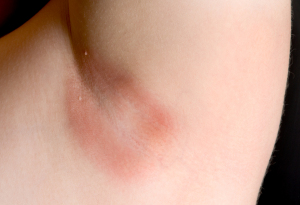Introduction
There are two types of yeast infections of the skin, namely candidiasis and tinea versicolor. Tinea versicolor has been described elsewhere. Here I am describing the skin infections of Candida albicans. Before I explain more about Candida infections of the skin we need to remind ourselves that Candida is a normal part of the skin flora. However, the skin barrier prevents the spores or the mycelium form to enter into skin. It is only when there is a breakdown of the skin layers that Candida albicans gets the nutrition from the host to invade the skin further and cause the rash. Candida albicans is the most common pathogen that causes candidiasis (yeast infection) of the skin, but there are about 3 other similar subtypes all belonging to the Candida family of yeast bugs.
Common locations of Candida skin infections
Skin involvement is common and there are a variety of body areas where physicians commonly find Candida skin infections. Here is a kaleidoscope of Candida skin infection presentations: in skin fold areas (below breasts in women, between the upper thighs, in the axilla and between the fingers); around the mouth, particularly in babies and young children; in the umbilicus. In cannery and laundry workers where the hands are frequently in water the nail folds can be affected, called paronychia due to Candida infection. But the nails themselves are also vulnerable (onychomycosis) to Candida infection. Here is a link to a site that contains several images regarding Candida skin infections (thanks to dermnetnz.org for this link, scroll down half-way to images).
Treatment of yeast infections of the skin
Topical nystatin or an azole (like clotrimazole, ketoconazole or fluconazole) is useful for many superficial skin infections. Vaginal infection is treated with oral fluconazole, possibly combined with topical clotrimazole. Onychomycosis is treated with oral fluconazole for several months. Many of these cases may require referral to a dermatologist.
References
1.The Merck Manual, 7th edition, by M. H. Beers et al., Whitehouse Station, N.J., 1999. Chapter 265.
2.James Chin et al., Editors: Control of Communicable Diseases Manual, 17th edition, 2000, American Public Health Association
3.The Merck Manual, 7th edition, by M. H. Beers et al., Whitehouse Station, N.J., 1999. Chapter 112.
4. The Merck Manual, 7th edition, by M. H. Beers et al., Whitehouse Station, N.J., 1999. Chapter 115.
5. The Merck Manual, 7th edition, by M. H. Beers et al., Whitehouse Station, N.J., 1999. Chapter 113.
6.David L. Heymann, MD, Editor: Control of Communicable Diseases Manual, 18th Edition, 2004, American Public Health Association.







